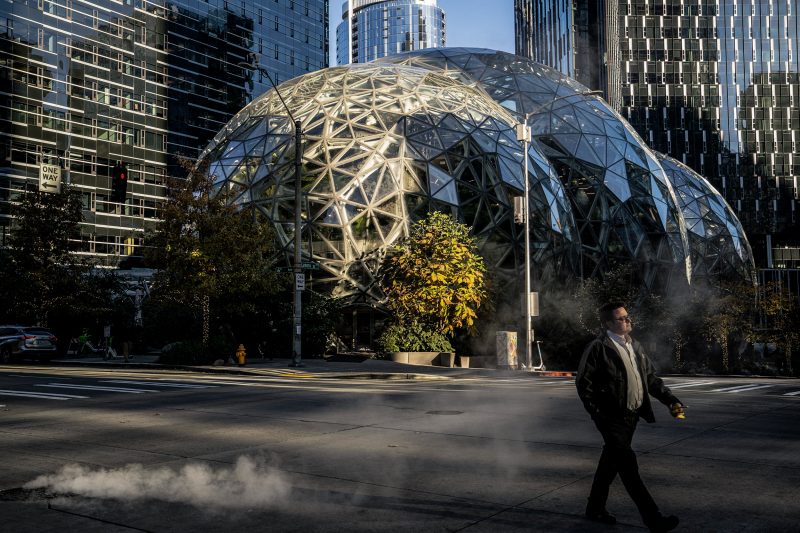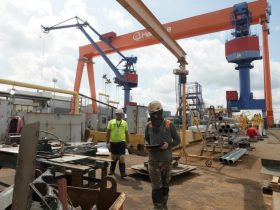At the beginning of the pandemic, waves of layoffs hit retail, leisure and hospitality workers — anyone whose job depended on in-person interactions.
But now that the pandemic is waning, those workers are in shorter supply — and now, it’s higher-paid employees who find themselves at the receiving end of layoff announcements.
Leading the cuts is the technology sector. On Wednesday, Amazon announced it was laying off 18,000 workers. That follows a total of 16,193 tech job losses in December, according to data from the Challenger, Gray and Christmas consultancy.
But while tech sector layoffs have largely captured headlines, it’s far from the only industry facing job losses.
Other brand-name firms announcing job cuts or hiring freezes in recent months, according to a list compiled by Reuters: Citigroup, Intel, HP, Microsoft, Johnson & Johnson, Phillips 66 and the Walt Disney Co.
It has the makings of a ‘white collar’ downturn. November jobs data from the U.S. Bureau of Labor Statistics showed significantly slower hiring or outright job declines across a range of white-collar industries. Notably, professional and business services hiring has slowed for four of the last five months, and November saw the sector register just 6,000 roles created nationally, the second-fewest jobs added in this phase of the pandemic.
Other sectors that saw significant hiring declines in November included employment services jobs; administrative support roles; and some lending and other credit-related occupations.
On the flip side, demand for workers whose jobs the pandemic endangered has come roaring back. It’s why food service jobs, as well as positions at hotels and retail stores, have had significant pay raises — though in many cases still not large enough to keep up with inflation.
‘What we’ve seen is massive hiring in the tech sector, big hiring over the last couple of years in service-producing sectors,’ said James Knightley, chief international economist at the financial services firm ING. ‘And now with the risk or growing concern of recession, some of these companies may have over-expanded during the vibrant post-pandemic reopening, and they’re now faced with more uncertainty.’
On Friday, the Bureau of Labor Statistics will release official jobs data for December. Analysts are forecasting a total of 200,000 jobs added, compared with 260,000 in November.
Over-expansion
In 2022, employers announced plans to cut 363,824 jobs, up 13% from the 321,970 cuts announced in 2021, according to Challenger.
The tech industry accounted for more than one-quarter of last year’s total job cuts, Challenger data show. More than two-thirds of 2022’s job cuts in tech were announced in November and December alone.
‘The tech sector was special. They over-expanded and over-hired,’ said William Lee, chief economist at the Milken Institute, a nonprofit, nonpartisan think tank. ‘They thought their ad revenues would continue forever, and once those started getting cut off in the post-pandemic era, they said, ‘My God, we’ve got too many people.”
Other white-collar industries are now being slammed with cuts, especially ones in interest-rate sensitive sectors like finance, real estate and automotive, Challenger data show. That’s due in large part to the Federal Reserve’s aggressive rate-raising campaign to combat inflation that hovered near 8% for much of 2022.
The financial industry announced 24,437 job cuts last year, compared with 10,784 in 2021, a 127% increase according to the Challenger data.
Finance firms across the board have announced cuts to their investment banking divisions as dealmaking has slowed, according to Andy Challenger, head of sales and media at Challenger. In November, Bloomberg reported that Citigroup planned to eliminate dozens of jobs in its investment banking division, while Reuters reported Morgan Stanley was also planning a fresh round of layoffs. Those announcements follow similar ones made by Goldman Sachs in September and Deutsche Bank in October.
The automotive industry saw 30,912 job cuts announced, compared with 10,469 in 2021. And real estate had 8,074 cuts announced last year, compared with 2,762 in 2021.
‘As interest rates have gone up, Americans are spending less on big ticket items,’ Challenger said. ‘We’ve seen a lot of job cuts around mortgage origination and fintech firms in mortgages. And then also on the housing side real estate agents — cuts around finding, buying and selling property.’
Other firms have invoked the slowing global economy to signal looming cuts. In October, Johnson & Johnson said it would look to ‘right-size’ its business amid inflationary pressures and a stronger U.S. dollar.
“We are looking at making sure that our resources are deployed on those projects, those initiatives, those services that really add the most value for our business,” J&J CFO Joseph Wolk told Reuters.
Two energy companies, Phillips 66 and Chesapeake Energy Corp., are also cutting jobs, including some corporate positions. Reuters reported the cuts at Phillips 66 would affect ‘salaried employees in management and upper-level technical services workers at several locations,’ while those at Chesapeake would affect its geologists and geoscientists.
Challenger and ING’s Knightley suggest that we could still be at the beginning of job cuts given the slowing economy. U.S.-based employers announced 76,835 cuts in November alone, more than double the 33,843 cuts announced in October and four-times the number of cuts announced last November, Challenger data show. December job loss announcements slowed slightly on the month, to 43,651, Challenger said.
“I do think we’re kind of at the start — we’ve just come out of the last two years being the lowest period for layoffs in American history,” Challenger added. “We were in such severe labor shortage, and now with the Fed raising rates, that affects all industries.”
The Conference Board’s most recent survey of CEOs revealed the lowest level of confidence among chief executives since 2009, with 98% saying they were preparing for a recession in the U.S.
‘The Fed is saying unemployment could hit 4.4 to 4.5%, which translates to about 1.2 million Americans losing jobs,’ Knightley said. ‘And that was when they were saying there wouldn’t be a recession, so we could see more Americans losing jobs than that.’
Knightley said the bursting of the tech bubble more than 20 years ago, which had economic conditions similar to today’s, resulted in about 2 million Americans losing their jobs.
‘That could be the order we’re talking about in terms of this downturn, but with more of a focus on white collar areas than manufacturing, where there are still real shortages,’ Knightley said.
Jobs obsolete?
A college degree remains the best predictor of employment: As of November, the unemployment rate stood at 2% for workers 25 and older with bachelor’s degrees or higher, compared with the 3.7% national rate. Even for workers 25 and older with just some college, the unemployment rate is a still-low 3.2%.
But a different measure of America’s jobs situation — the overall labor force — reveals a more troubling pattern. The size of the labor force composed of college graduates aged 25 and older has shrunk for three-straight months after peaking at 63.7 million, equivalent to losses of 648,000 workers who are no longer looking for work if they find themselves out of a job.
That’s the biggest sustained loss since the outset of the pandemic.
For those with only some college education, the situation is even more dire: The pandemic has caused that labor force to shrink by 1.5 million workers to a total of 35.9 million, and now sits at a level not seen since April 2007.
‘I think looking at middle-management jobs — that’s what we think they are — there might have been a lot stress on those managers,’ said Jane Oates, president of WorkingNation, a nonprofit focused on work force development. ‘They might be taking a pause to reduce the stress.’
These trends may speak to more structural economic challenges than slowing economic growth, experts say.
‘Companies are starting to reshape their businesses,’ said the Milken Institute’s Lee. ‘They want to be more profitable for this age where labor is scarce and expensive, so they’re incorporating more technology.’








